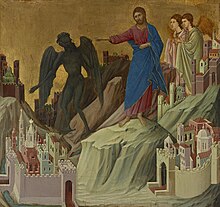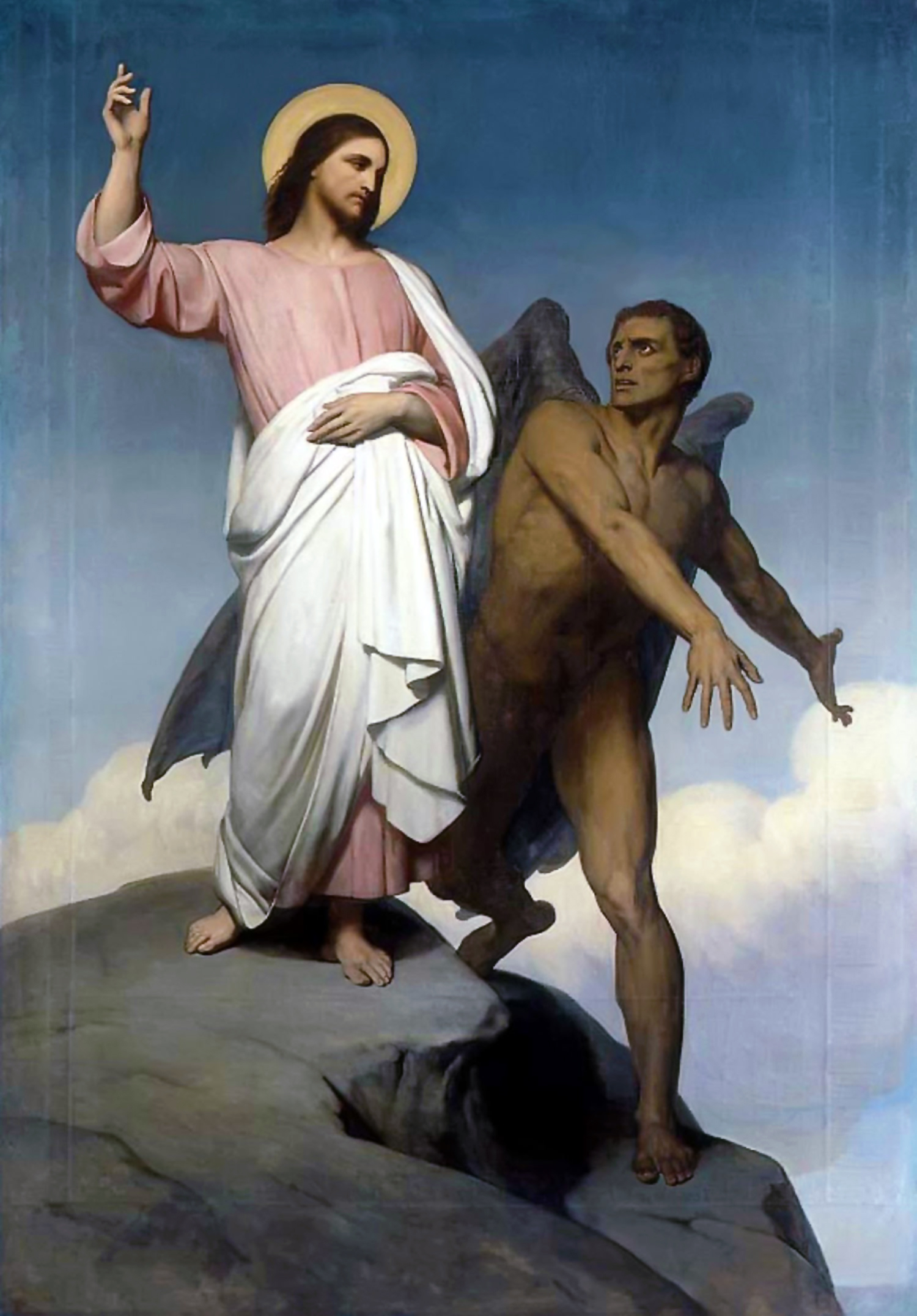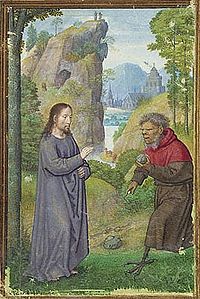Temptation of Christ
From Wikipedia, the free encyclopedia
The temptation of Christ is detailed in the gospels of Matthew,[1] Mark,[2] and Luke.[3] According to these texts, after being baptized, Jesus fasted for forty days and nights in the desert. During this time, the devil appeared to Jesus and tempted him. Jesus having refused each temptation, the devil departed and angels came and brought nourishment to Jesus.
Mark's account is very brief, merely noting the event. Matthew and Luke describe the temptations by recounting the details of the conversations between Jesus and the devil. Since the elements that are in Matthew and Luke but not in Mark are mostly pairs of quotations rather than detailed narration, many scholars believe these extra details originate in the Q Document. The story of the Temptation is one of the notable Omissions in the Gospel of John.
Contents[hide] |
[edit] Literary Genre
The account of Matthew uses language from the Old Testament. The imagery of a conflict between an earlier "Jesus" and "the devil" would be familiar to Matthew's contemporary readers, recalling the vision of a conflict between Satan and the Angel of the Lord. In the Septuagint Greek version of Zechariah 3 the name Iesous and term diabolos are identical to the Greek terms of Matthew 4.[4] Additionally Matthew presents the three scriptural passages cited by Jesus (Deut 8:3, Deut 6:13, and Deut 6:16) not in their order in the book of Deuteronomy, but in the sequence of the trials of Israel as they wandered in the desert, as recorded in the book of Exodus.[5][6]
Luke's account is similar, though his inversion of the second and third temptations "represents a more natural geographic movement, from the wilderness to the temple".[7] Luke's closing statement that the devil "departed from him until an opportune time"[8] may provide a narrative link to the immediately following attempt at Nazareth to throw Jesus down from a high place,[9] or may anticipate a role for Satan in the Passion (cf. Luke 22:3).[10][11]
[edit] Accounts
In Luke's and Matthew's accounts, the devil tempts Jesus to:
- Make bread out of stone(s) to relieve his own hunger
- Free himself from a pinnacle by jumping and relying on angels to break his fall. The narrative of both Luke and Matthew has the devil quote Psalm 91:11-12 to show that God had promised this assistance, although the devil omits the part of that passage which makes clear that the guarantee applies only to accidents, not deliberate jumps.[reference needed]
- Worship the devil in return for all the kingdoms of the world. Luke has the devil explicitly claim this authority had previously been handed to himself, the devil.

Matthew makes clear that the Spirit (presumably the same Spirit (or "Holy Ghost" depending on which translation you read) prominently mentioned only two verses before) has led Jesus into the desert. Many scholars see Matthew as presenting Jesus being tested under the orders of God, rather than the devil being opportunist. The Catholic and Orthodox teaching is that the Devil and the other demons are spiritual or angelic creatures created by God in a state of innocence, and that they became evil by their own act. Other non-Christian teachings[which?] see the devil's role here as echoing Satan's role in some parts of the Old Testament, or as taught in Modern Day Rabbinic Judaism where he is portrayed as an angel acting under God's orders as an official "opposing counsel" to test humans on behalf of God. Thus there are two understandings of Satan, the Christian one of a Satan who is a fallen angel in rebellion to God who became evil, and the Jewish one of a Satan who is not an evil fallen angel, but a servant of God carrying out God's will.
[edit] Fasting
Fasting traditionally presaged a great spiritual struggle.[12] Elijah and Moses in the Old Testament fasted 40 days and nights, and so Jesus doing the same invites comparison to these events. At the time, 40 was less a specific number and more a general expression for any large figure.[13] Fasting does not necessarily mean a complete abstinence from food and consequently that Jesus may have been surviving on the sparse food that could be obtained in the desert.[14][15]
[edit] Locations
Each temptation takes place in a different setting.
[edit] 1. Stones to Bread
The temptation of making bread out of stones occurs in the same desert setting where Jesus had been fasting. Jones reports that the wilderness mentioned here has since the fifth century been believed to be the rocky and uninhabited area between Jerusalem and Jericho, with a spot on Mount Quarantania traditionally being considered the exact location. The desert was seen as outside the bounds of society and as the home of demons such as Azazel (Leviticus 16:10). Some have read this reference to the wilderness as a comparison to Adam in the Garden of Eden, implying that Jesus will be a new Adam (cf Book of Romans 5) . However scholars like Gundry reject this idea, stating that nowhere does Matthew's text imply such a comparison, but rather the desert is more likely an allusion to the wilderness through which the Israelites wandered during the Exodus, and more specifically to Moses.[15] Jesus replies, "It is written: 'One does not live by bread alone, but by every word that comes forth from the mouth of God.'"[16]

[edit] 2. Pinnacle of the Temple
After the first temptation is rejected, the devil takes Jesus to a high pinnacle in what Matthew terms the holy city. Most Christians consider that holy city refers unquestionably to Jerusalem and the temple to which the pinnacle belongs is thus identified as the Temple in Jerusalem. Gospel of Matthew refers to "the temple" 17 times without ever adding "in Jerusalem". That Luke's version of the story clearly identifies the location as Jerusalem may be due to Theophilus's unfamiliarity with Judaism.[17]
What is meant by the word traditionally translated as pinnacle is not entirely clear since the Greek dimunitive form pterugion ("little wing") is not extant in other architectural contexts.[18]. Though the form pterux ("large wing") is used for the point of a building by Pollianus [19] Schweizer feels that little tower or parapet would be more accurate, and the New Jerusalem Bible does use the translation "parapet". The only surviving Jewish parallel to the temptation uses the standard word šbyt "roof" not "wing": "Our Rabbis related that in the hour when the Messiah shall be revealed he shall come and stand on the roof (šbyt) of the temple" (Peshiqta Rabbati 62 c-d) [20]
Gundry lists three sites at the Jerusalem temple that would fit this description[15]:
- On the top of the temple's main tower, above the sanctuary proper, some 180 feet above ground, the location that artists and others using the traditional translation generally set the story.
- Atop the lintel of the main gateway into the temple, the most prominent position where the pair could easily have been seen.
- A tower on the southeast corner of the outer wall that looks down into the Kidron Valley, which James the Just was said to have later been thrown from by way of execution.
Once more, Jesus maintained his integrity and responded by quoting scripture, saying, "Again it is written, 'You shall not put the Lord, your God, to the test.'"[21]
[edit] 3. Mountain
For the final temptation, the devil takes Jesus to a high place, which Matthew explicitly names a mountain, where all the kingdoms of the world can be seen. Interpretations of this are as follows:
- The teller of this story believed the earth was flat.
- John Calvin supported the view that the devil took Jesus to a vision of a high place where he could see the entire world, and the Geneva Bible translates the passage in this way.
- kingdoms could be a reference to power rather than geography.
- all...of the world could refer only to the "known world", a comparatively small region at the time of Matthew.
- Satan flew Jesus to a mountain top and from there flew him around the entire world. Jesus normally walked from place to place.
- The mountain is not literal if the whole temptations only occur in the mind's eye of Jesus. For example if the Gospel accounts record this mind's eye view, as related in parable form, to the disciples at some point during the ministry.[22]
Jesus replies "Get away, Satan! It is written: 'The Lord, your God, shall you worship and him alone shall you serve.'"[23]
[edit] Purpose

Exactly what the devil was trying to achieve by these temptations has been open to debate. The traditional view is that the devil on each occasion is trying to make Jesus commit a particular sin - avarice by offering power over the kingdoms of the world, gluttony by suggesting a way to relieve Jesus' hunger, and hubris by suggesting that Jesus jump and rely on angels to break his fall. Most modern scholars do not accept this view, Jones for example noting that labeling someone a glutton after a fast because of the temptation of food is hyperbole.[24]
Another view popular for a time (for example, see Dostoyevsky's The Grand Inquisitor in The Brothers Karamazov) was that the devil wasn't so much tempting Jesus as presenting him with the different options he could take to be a Messiah, and making him choose one. Evangelicals point to the word usually translated as tempt as being more accurately translated as test, i.e. that the devil was testing Jesus' understanding of his role rather than trying to lure him to sin.[14] Rejected options under this interpretation are:
- Someone who alleviates physical hardships, as manifested by miraculously feeding himself when hungry
- A magician and miracle worker who wins converts by spectacular acts, as manifested by surviving a jump from a high pinnacle. That the devil places Jesus in a very public location, rather than the numerous high pinnacles in the desert, gives credence to this view.
- A political liberator from the oppression of the Romans, as manifested by having power over the kingdoms of the world
Another view, popularized by the book The Politics of Jesus by John Howard Yoder, suggests that the three temptations of Jesus foreshadow the three points in his ministry where political temptations were the greatest:
- right after the miracle of the loaves and fish was performed, when the hungry crowds wanted to make him king;
- when he cleansed the Temple, at which time he had already secured enough political and moral support from the crowds to start a political movement; and
- the night at Gethsemane when he played with the idea of calling on twelve legions of angels to stop his arrest - he could have initiated a holy war should he choose to.
There remains the question of the validity of the temptations offered to Jesus. As the Son of God, he would be able to attain any of these desires without the aid of the Devil. He was, in essence, being tempted with offers that he already had in his hand.
[edit] Jesus' banquet

Once the temptations are over, the narrative has the devil depart and Jesus being looked after by angels. In the original Greek of Matthew, "devil left him" was in the historic present tense, indicating a lack of permanence, i.e. that the devil would later return to further tempt Jesus (which Luke spells out explicitly). While both Mark and Matthew mention the angels, Luke does not, and Matthew seems once again here to be making parallels with Elijah[25], who was fed by ravens. The word minister/served is often interpreted as the angels feeding Jesus, and traditionally artists have depicted the scene as Jesus being presented with a feast, a detailed description of it even appearing in Paradise Regained. This ending to the temptation narrative may be a common literary device of using a feast scene to emphasize a happy ending[13], or it may be proof that Jesus never lost his faith in God during the temptations.[24] In the War Scroll found at Qumran, angels are described as forming an army to battle evil, which is somewhat at odds with most interpretations of the portrayal of angels here, but it could indicate that the angels in the passage should instead be interpreted as ministering to Jesus by driving off the devil. After forty days and nights of no food, Jesus needed sustenance and once the temptations had ceased, miraculous aid was at hand. God kept his promise to take care of Jesus.
[edit] Parallels in Gospel of John
The story of the Temptation is one of the notable Omissions in the Gospel of John. However some readers have identified parallels inside John which indicate that the author of John may have been familiar with the Temptation narratives in some form.[26]
- Stones into Bread → John 6:26,31 to make bread in the wilderness.
- Jump down from the temple → John 2:18 to perform a Messianic sign in the temple.
- Kingdoms of the World → John 6:15 to take the kingdom by force.
[edit] Cultural influences
The temptation of Christ has been a frequent subject in the art and literature of Christian cultures. It is largely the subject of John Milton's four-book epic, Paradise Regained. Fyodor Dostoyevsky's The Grand Inquisitor, part of the novel The Brothers Karamazov, features an extended treatment of the temptation of Christ. Andrew Lloyd Webber's Jesus Christ Superstar has brief references to Christ being tempted by mortal pleasures and Stephen Schwartz devotes a scene to it in Godspell. A stanza on the poem "O Operário em Construção" ("The Building Operary"), by Vinícius de Moraes, alludes to the temptation as well. Lastly, the film Jesus of Montreal has a parallel scene where the actor playing Jesus is taken to the top of a skyscraper and offered lucrative contracts by a lawyer if he will serve him.
[edit] Parallels in Other Religions
In Buddhist tradition, the god of Illusion tempts the Buddha in various ways, including urging him to transform the Himalayas into gold.
In Egyptian tradition, Horus fled to the desert and was tempted by Set, the Egyptian God of evil and chaos. Much like Jesus, Horus resisted the temptation (though not before being blinded in one eye).


Inga kommentarer:
Skicka en kommentar